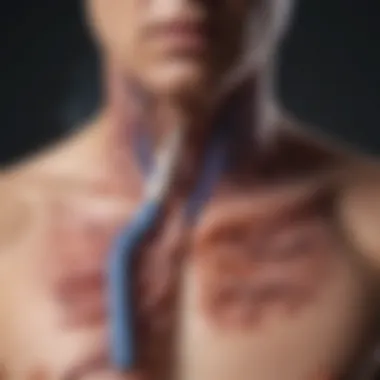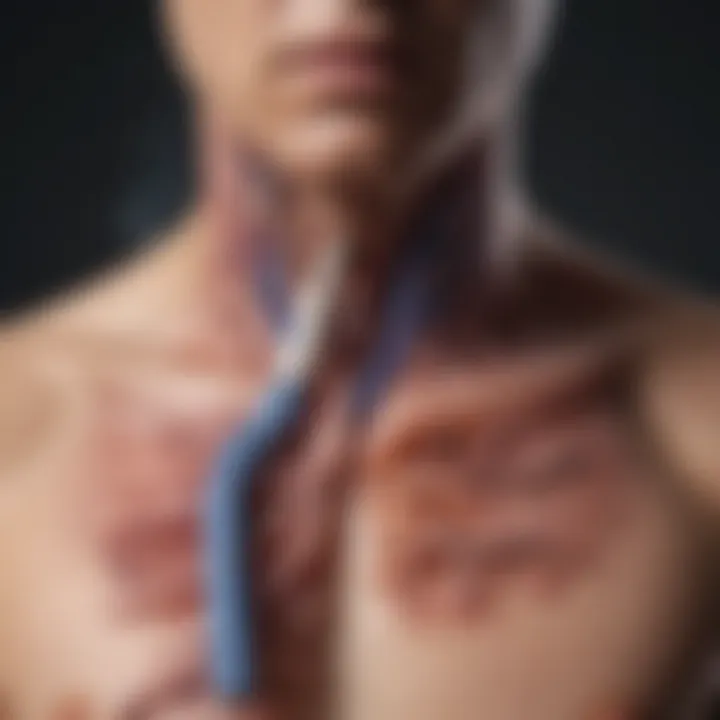Smoking's Role in Esophageal Cancer: A Detailed Study


Intro
Esophageal cancer is a significant health concern worldwide. The intricacies surrounding its development involve multiple factors including genetics, environment, and lifestyle choices. Smoking emerges as a crucial variable in this complex interplay. Understanding this relationship is necessary for both prevention and treatment strategies. The following sections will explore how smoking does contribute to esophageal cancer, analyze relevant research, and discuss both the biological mechanisms involved and the statistics affirming this link.
Overview of Research Topic
Brief Background and Context
Esophageal cancer primarily affects the esophagus, the tubular structure that connects the throat and stomach. This cancer has multiple histological variants, the most common being squamous cell carcinoma and adenocarcinoma. Smoking has been identified for decades as a significant risk factor for many forms of cancer. Specifically, in relation to esophageal cancer, studies have demonstrated a strong correlation between tobacco use and increased incidence rates. Various chemicals found in tobacco smoke have a direct effect on the cells of the esophagus, causing mutations that may lead to cancer.
Importance in Current Scientific Landscape
The scientific community recognizes the impact of smoking on esophageal cancer as a pressing issue. Current literature consistently shows smoking not only raises risk but also influences tumor biology. This relationship inflicts a broader public health concern given the pervasive nature of smoking worldwide. Medical professionals and researchers emphasize the necessity for awareness, prevention, and treatment adaptations informed by these findings. A comprehensive understanding of how smoking affects esophageal health can drive efforts in reducing tobacco consumption and enhancing screening protocols for those at risk.
Methodology
Research Design and Approach
This article will utilize a review methodology to synthesize existing studies and publications related to the impact of smoking on esophageal cancer. By focusing on peer-reviewed research and official cancer statistics, this approach ensures the reliability and validity of the information presented. Research studies covering various populations, smoking regimens, and outcomes will be included. This wide scope of data brings clarity to the multi-dimensional aspects of the smoking-esophageal cancer relationship.
Data Collection Techniques
Data for this exploration involves retrospective analyses of epidemiological studies, cancer registries, and meta-analyses. Moreover, significant emphasis will be placed on both qualitative and quantitative research findings. Detailed examination of biological experimentation where tobacco’s carcinogenic effects are evaluated will add critical dimensions to our understanding.
It is essential to recognize that smoking is a modifiable risk factor for esophageal cancer. This offers a pathway for effective public health interventions.
Both methodological approaches underscore the importance of robust evidence in linking smoking to esophageal cancer, serving to inform future research and preventative strategies. The subsequent sections will delve deeper into the specific mechanisms through which smoking contributes to cancer development, along with risk factors and treatment insights.
Preamble to Esophageal Cancer
Understanding esophageal cancer is crucial in discussing the link between smoking and this disease. This section provides foundational knowledge about the cancer itself, which is important for grasping how risk factors like smoking play a significant role in its development.
Esophageal cancer affects the esophagus, which is the tube that carries food from the mouth to the stomach. It can severely impact one’s quality of life.
Definition and Overview
Esophageal cancer is defined as uncontrolled cell growth in the tissues of the esophagus. This kind of cancer can arise from various factors, including inflammation, dietary habits, and, notably, smoking. The symptoms often include difficulty swallowing, weight loss, and chest pain, which can be alarming. Understanding these aspects is significant because the earlier the cancer is detected, the better the chances for successful treatment.
Types of Esophageal Cancer
There are two primary types of esophageal cancer: adenocarcinoma and squamous cell carcinoma. Each of these types differs in origin and response to risk factors like smoking, making their study essential in this article.
Adenocarcinoma
Adenocarcinoma arises from the glandular cells in the esophagus or gastroesophageal junction. One key characteristic of adenocarcinoma is its increasing prevalence in Western countries, linked closely to obesity and smoking. The rise in cases highlights the contributing factors at play, showing how lifestyle choices can affect health outcomes.
A major feature of adenocarcinoma is its association with Barrett's esophagus, which is a condition that can result from long-term gastroesophageal reflux disease (GERD). This connection is crucial in understanding how certain behaviors, such as smoking, may elevate the risk of developing adenocarcinoma. While treatment options are available, such as surgery and chemotherapy, the prognosis can greatly depend on early detection and intervention.
Squamous Cell Carcinoma
Squamous cell carcinoma originates from the flat cells lining the esophagus. This type is more commonly found in developing countries and is significantly associated with smoking and alcohol use. One key feature of squamous cell carcinoma is its potential to develop rapidly, often leading to a delay in diagnosis as symptoms may not arise until the disease has progressed.
The unique aspect of squamous cell carcinoma lies in its varied risk factors. While smoking plays a major role, nutritional deficiencies and certain infections also contribute to its onset. Understanding these factors not only provides insights into prevention but can also guide treatment decisions, ensuring a tailored approach for patients.
In summary, both types of esophageal cancer underscore the importance of studying smoking as a risk factor. Each type reveals valuable information about how lifestyle choices can dramatically shape health outcomes. Understanding these connections fosters a more comprehensive discussion of smoking, its dangers, and how it relates to esophageal health.
The Role of Smoking in Esophageal Cancer
Understanding the role of smoking in esophageal cancer is crucial due to its significant impact on patient outcomes. Smoking is not just a lifestyle choice; it is a primary risk factor contributing to the onset of this aggressive disease. As research increasingly ties smoking to various types of cancers, the specific link to esophageal cancer highlights critical insights into prevention and treatment strategies.
Epidemiological Evidence


Epidemiological studies consistently show a strong association between smoking and an increased risk of esophageal cancer. Data indicates that smokers are several times more likely to develop this disease compared to non-smokers. This risk is influenced by the duration and intensity of smoking. In fact, research suggests that even individuals who quit smoking can still maintain an elevated risk years after cessation. Studies published in journals such as Cancer Causes & Control provide comprehensive statistics that underscore the importance of addressing smoking in esophageal cancer prevention efforts.
Mechanisms of Carcinogenesis
Chemical Components of Tobacco
The chemical composition of tobacco plays a pivotal role in the carcinogenic process. Tobacco contains numerous toxic substances, such as tar and formaldehyde. These components can directly damage the cells of the esophagus. Furthermore, the chemicals enter the bloodstream, affecting not just the respiratory system but also targeting the digestive pathway. This volatility increases the chances of mutations in genes related to cell growth and repair, driving the onset of cancer. In articles discussing carcinogens, it is frequently noted that these chemical components create an environment that fosters cancer development. Thus, the tobacco components' distinct characteristics make it vital to understand their implications for esophageal cancer.
DNA Damage and Mutations
DNA damage and mutations are critical in the discussion of esophageal cancer. Smoking introduces harmful substances that can lead to specific mutations in DNA. These mutations disrupt the normal regulation of cell division, leading to uncontrolled growth—a hallmark of cancer. Furthermore, certain genetic mutations linked to smoking can predispose individuals to esophageal cancer. The persistent nature of DNA damage exposes the unique challenges faced in both early detection and prevention strategies. This evidence of damage is alarming, emphasizing the need for continued research in this area.
"The connection between smoking and esophageal cancer is not merely statistical; it involves complex biological processes that lead to cell mutations and malignancies."
Understanding the role smoking plays in esophageal cancer not only informs public health strategies but also encourages smokers to consider the long-term risks associated with their habits. It provides a firm basis for interventions aimed at reducing smoking prevalence, thereby decreasing esophageal cancer incidents.
Risk Factors Associated with Esophageal Cancer
Understanding the risk factors associated with esophageal cancer is crucial in grasping the overall impact of smoking on this disease. These factors can shape the likelihood of developing cancer in various populations. Knowing them allows for targeted preventive measures and educational efforts.
Through thorough research, it becomes evident that both lifestyle choices and genetic predispositions play significant roles in this cancer's development.
Lifestyle Factors
Alcohol Consumption
Alcohol consumption is a key lifestyle factor linked to esophageal cancer. Studies show that heavy drinking significantly increases risks, particularly when combined with smoking. This synergy results in a far greater risk than either factor alone. Alcohol can cause damage to the esophagus lining, making it more vulnerable to carcinogens found in tobacco.
One critical characteristic of alcohol consumption is how it can act as a solvent for harmful chemicals. This facilitates their absorption into the body. Citrus fruits and high-fat diets can aggravate irritation, while moderate alcohol intake offers no benefits concerning cancer risk. This aspect makes it an important subject for analysis in relation to smoking and esophageal cancer.
The unique feature of alcohol consumption is its widespread social acceptance, often complicating discussions about its dangers. Not everyone recognizes its potential to contribute to severe health issues like esophageal cancer. The disadvantages of continued high alcohol consumption thus become evident, reinforcing the need for awareness and strategy.
Dietary Habits
Dietary habits also hold considerable influence over esophageal cancer risks. A balanced diet rich in fruits and vegetables can potentially mitigate some risks. Certain foods may contain antioxidants that help combat oxidative stress caused by smoking.
The key characteristic of dietary habits that makes them relevant to this discourse is their ability to modify cancer risk profiles. Diet plays a pivotal role in overall health. Notably, some studies indicate that diets high in processed meats and low in fiber may elevate cancer risks.
Moreover, the unique advantage of healthy dietary habits is their capacity to enhance resilience against other lifestyle factors. A nourishing diet not only aids in maintaining a healthy weight but also supports a robust immune system. This, in turn, puts the body in a better position to fight off diseases, including cancer.
Genetic Predisposition
Genetic predisposition to esophageal cancer can further complicate the landscape of risk factors. Family history can indicate susceptibility to this disease, as inherited genetic mutations may increase the likelihood of developing it. Understanding one’s genetic background can prove essential in assessing individual risks. Genetic testing can offer insights that inform personalized prevention strategies.
High-risk populations, for instance, may benefit from increased vigilance and regular screenings. Additionally, those with known mutations related to esophageal cancer should receive tailored lifestyle recommendations.
These genetic factors, combined with smoking and dietary habits, create a nuanced view of cancer risks. This multilayered perspective helps us appreciate the various elements that interact to influence health outcomes.
Statistical Insights on Smoking and Esophageal Cancer
The significance of statistical insights regarding smoking and esophageal cancer lies in their ability to illustrate the relationship between behavioral choices and health outcomes. Understanding these statistics helps in recognizing the severity of the problem, allowing healthcare professionals and policymakers to allocate resources effectively. This section will elaborate on two critical aspects: incidence rates of esophageal cancer related to smoking, and the global trends that indicate the impact smoking has on this disease.
Incidence Rates
Incidence rate is a crucial measure that indicates how often a disease occurs in a specific population over a time period. In the case of esophageal cancer, research shows that smoking greatly contributes to increased incidence rates. The American Cancer Society reports that about 20% of esophageal cancer instances are linked to smoking. Specifically, squamous cell carcinoma, which is one of the primary types of this cancer, shows a higher incidence among smokers compared to non-smokers.
Recent data indicate that men who smoke are three to six times more likely to develop esophageal cancer compared to non-smokers. This highlights the elevated risk associated with smoking and encourages a need for effective public health campaigns.
"Statistics provide a clear picture of the connection between smoking and esophageal cancer, pointing towards an urgent need for preventive measures."
Global Trends
Understanding global trends provides insight into the overall impact of smoking on esophageal cancer worldwide. The World Health Organization indicates that regions with high smoking rates also report elevated cases of esophageal cancer. For instance, countries in East Asia and Eastern Europe have some of the highest rates of both smoking and esophageal cancer incidence.


In addition, shifting smoking patterns can also affect future trends of esophageal cancer. As smoking rates decline in some high-income countries due to successful public health initiatives, there is still a concerning rise of smoking habits in low- to middle-income countries. This shift could lead to an increase in esophageal cancer cases in regions where effective smoking cessation programs are not yet established.
Prevention Strategies
Understanding effective prevention strategies is essential in reducing the incidence of esophageal cancer, particularly when considering the influence of smoking. Preventing this disease requires a multifaceted approach that addresses both individual behaviors and broader public health initiatives. The following subsections will elaborate on specific strategies that can aid in lowering the risks associated with smoking and subsequently prevent esophageal cancer.
Smoking Cessation Programs
Smoking cessation programs are critical in combating the addictive nature of tobacco and the associated health risks, including esophageal cancer. These programs often employ a range of methods, including behavioral support, counseling, and sometimes pharmacological aids. Engaging in such programs can yield significant benefits, as studies indicate that quitting smoking drastically reduces the risk of developing esophageal cancer over time.
- Behavioral Support: Many programs offer counseling sessions that encourage participants to share experiences, challenges, and strategies for quitting. Group therapies can enhance motivation and accountability among participants.
- Pharmaceutical Aids: Nicotine replacement therapies, such as patches or gum, help manage withdrawal symptoms. Medications like varenicline and bupropion have proven effective in assisting individuals to quit smoking.
- Personalized Plans: Tailoring smoking cessation strategies to individual preferences and needs increases the likelihood of success. Personalized plans can address specific triggers, routines, and environmental factors influencing smoking habits.
Overall, the success of these programs can be attributed not only to the support provided but also to creating an understanding of the health risks linked to smoking, including esophageal cancer.
Public Health Initiatives
Public health initiatives play a vital role in decreasing the prevalence of smoking and its effects on esophageal cancer. These initiatives often involve comprehensive campaigns that seek to educate the population on the dangers of smoking, promote smoking cessation, and limit tobacco use in society.
- Education Campaigns: Informing the public about the risks of smoking and the benefits of quitting is fundamental. Public health messages are often disseminated through various media channels, aiming to reach diverse demographics.
- Policy Changes: Implementing strict regulations on tobacco advertising and sales significantly decreases smoking rates. Measures include increasing taxes on tobacco products, restricting smoking in public spaces, and enforcing age limits for tobacco purchase.
- Support Services: Governments and health organizations may provide resources, such as free hotlines and online support, to assist individuals in quitting smoking. Enhancing access to cessation services is essential in promoting long-term recovery from tobacco dependency.
- Community Programs: Local initiatives can foster environments conducive to quitting smoking. This could include smoke-free public zones or community centers offering workshops focused on smoking cessation.
Symptomatology and Diagnosis
Understanding the symptomatology and diagnosis of esophageal cancer is vital. Early detection can lead to improved outcomes. Symptoms may vary based on the stage of cancer. Recognizing these symptoms is important for timely intervention. Additionally, diagnostic methods are crucial in confirming diagnoses and determining appropriate treatment plans.
Common Symptoms
Esophageal cancer manifests through several common symptoms. Patients often report:
- Dysphagia: Difficulty swallowing is one of the most notable symptoms. It often worsens over time, leading patients to avoid solid foods.
- Chest Pain: Some individuals may experience discomfort or pain in the chest area.
- Unexplained Weight Loss: Weight loss without trying can be a significant red flag for many patients.
- Chronic Coughing: A persistent cough may occur, contributing to the overall discomfort.
- Heartburn or Indigestion: Many patients experience frequent heartburn, which is often mistaken for less serious conditions.
Recognizing these symptoms early can drive individuals to seek medical help, which is essential for effective management.
Diagnostic Approaches
Diagnosis of esophageal cancer employs various approaches to ensure accurate results. The primary methods include endoscopy and biopsies.
Endoscopy
Endoscopy is a critical diagnostic tool in the evaluation of esophageal conditions. During this procedure, a long, flexible tube equipped with a camera is inserted through the mouth into the esophagus. The key characteristic of endoscopy is its ability to provide real-time visualization of the esophageal lining. This makes it particularly valuable in identifying abnormalities.
- Benefit: Endoscopy is minimally invasive and allows for direct observation of the esophagus and surrounding tissues.
- Unique Feature: Physicians can perform interventions during the procedure, such as taking tissue samples if necessary.
- Advantages: It provides immediate feedback, which can expedite further testing or treatments. However, it does require sedation.
Biopsy Techniques
Biopsy techniques are essential for confirming the presence of cancer. During a biopsy, small samples of tissue are obtained for pathological examination. This procedure is often performed during endoscopy. The key characteristic of biopsy techniques is their ability to offer definitive diagnoses via histological analysis.
- Benefit: The confirmation of cancer type and stage is crucial for formulating effective treatment strategies.
- Unique Feature: Different methods of biopsy, such as fine needle aspiration or excisional biopsy, allow for tailored approaches based on individual cases.
- Advantages/Disadvantages: While biopsies are generally safe, there may be risks of complications such as bleeding or infection. Nevertheless, the potential benefits of gaining a clear diagnosis typically outweigh the risks.
Early diagnosis through symptom recognition and appropriate testing is crucial for improving survival rates in esophageal cancer.
Treatment Options for Esophageal Cancer
Understanding treatment options for esophageal cancer is crucial. The methods of treatment vary based on individual factors, including the stage of cancer and overall health. Effective treatment not only aims to remove cancerous tissues but also focuses on improving survival rates and quality of life for patients. This section explores major treatment modalities including surgical interventions, radiation therapy, and chemotherapy. Each of these options carries different implications for patients and emphasizes the necessity for personalized treatment plans.
Surgical Interventions
Surgery offers a primary approach for treating esophageal cancer, especially when diagnosed at an earlier stage. The goal is to remove tumor tissue along with a margin of healthy tissue. There are several surgical procedures, the most common being the esophagectomy. This procedure entails removing part or all of the esophagus, followed by reconstruction.
Patients undergoing surgery must consider recovery time and potential side effects. Risks include infection and complications related to anesthesia. Furthermore, surgery may affect eating and digestion, requiring dietary adjustments post-operation. However, successful surgical interventions can lead to long-term remission, making it a compelling option for many patients.
Radiation Therapy


Radiation therapy utilizes high-energy waves to target and destroy cancer cells. It can be applied either as a primary treatment or in conjunction with other modalities, such as surgery. For patients who cannot undergo surgery, radiation may be the only treatment option available. Additionally, it is often used post-surgery to eliminate any residual cancerous cells.
This therapy is usually administered externally, though there is a form called brachytherapy that involves placing radioactive sources within the esophagus. Side effects are common, with fatigue and skin irritation being prominent. Patients may also experience difficulty swallowing. Nevertheless, radiation therapy’s ability to shrink tumors can provide significant relief from symptoms, enhancing the patient’s quality of life.
Chemotherapy
Chemotherapy involves the use of drugs to kill cancer cells. For esophageal cancer, it can be employed as neoadjuvant therapy, prior to surgery, to reduce tumor size, or as adjuvant therapy following surgery to lower the chance of cancer returning. It may also be used when cancer has spread to other parts of the body.
Modern treatment regimens may include targeted therapies designed to act on specific molecular features of cancer cells. These drugs can potentially improve effectiveness and reduce side effects. Common side effects of chemotherapy might include nausea, vomiting, and hair loss. However, these can often be managed with supportive care. Ultimately, chemotherapy can be a vital component of a comprehensive cancer care plan, contributing to better overall survival outcomes.
In summary, surgery, radiation, and chemotherapy each play a significant role in treating esophageal cancer. The choice of treatment must involve comprehensive evaluation by a multidisciplinary medical team, considering each patient’s unique circumstances and preferences.
Prognosis and Survival Rates
Understanding prognosis and survival rates in esophageal cancer is critical for both patients and healthcare professionals. Prognosis refers to the likely course of the disease and the chances of recovery, while survival rates provide statistical data about the percentage of people living with the condition for a specific period after diagnosis. This information shapes treatment decisions, guides expectations, and helps in planning for potential outcomes.
Factors Influencing Prognosis
The prognosis for someone diagnosed with esophageal cancer can vary significantly based on several factors:
- Stage of Cancer: The stage at which the cancer is diagnosed remains the most important factor. Early-stage cancer typically offers a better prognosis than later stages.
- Tumor Location: The location of the tumor within the esophagus can impact treatment choices and survival rates. Tumors closer to the throat may present greater challenges during surgical interventions.
- Histology Type: The specific type of esophageal cancer, whether adenocarcinoma or squamous cell carcinoma, also affects prognosis. Each type has its own characteristics and treatment responses.
- Patient's Overall Health: Comorbidities and the patient’s general physical condition can influence recovery. Those in better health before diagnosis often fare better.
- Smoking Status: Continuing to smoke after diagnosis has been linked to poorer outcomes. Smoking cessation can improve prognosis by reducing complications and improving treatment efficacy.
Long-term Outcomes
Long-term outcomes for esophageal cancer patients are generally measured by survival rates, often categorized as the 5-year relative survival rate. Some critical insights include:
- Early-stage Survival Rates: For localized esophageal cancer, where the cancer is confined to the esophagus, the 5-year survival rate can range from 40% to 60%.
- Regional Spread: If the cancer has spread to nearby lymph nodes, the survival rate drops, typically hovering around 20% to 30% for the 5-year mark.
- Distant Metastasis: In cases where the cancer has metastasized to distant organs, the overall survival rate can fall below 5%.
- Impact of Treatment: Those who undergo a combination of surgery, followed by chemotherapy or radiation, may experience improved long-term outcomes compared to those receiving no treatment.
- Follow-up Care: Regular follow-up care plays a significant role in monitoring for recurrence and managing any long-term side effects of treatment.
The prognosis for esophageal cancer varies. The key factors influencing survival include the cancer's stage, treatment response, and lifestyle choices, including smoking.
Emphasizing prevention and early detection is crucial. Continued research into effective treatments can improve long-term outcomes for patients.
The Future of Research on Smoking and Esophageal Cancer
Research on the link between smoking and esophageal cancer continues to advance. Understanding this relationship is crucial for both prevention and treatment. As researchers explore new aspects of how smoking affects esophageal health, they are likely to uncover further insights that can improve health outcomes.
Emerging Studies
Recent studies are focusing on various dimensions of the smoking-esophageal cancer link. For instance, large-scale cohort studies aim to assess long-term effects of smoking across different populations. These studies analyze how demographic factors, such as age and ethnicity, influence cancer risk.
Another line of inquiry involves genetic predispositions in smokers. Researchers are examining how specific genetic markers interact with tobacco exposure, potentially leading to an increased chance of developing esophageal cancer. This approach could personalize prevention measures and treatment options based on genetic profiles.
Moreover, studies are investigating the role of electronic cigarettes. As usage of these products increases, researchers are assessing if they pose similar risks to traditional smoking. This is especially relevant given the rising popularity of vaping among younger adults.
Innovative Treatment Approaches
In parallel with research on causes, innovative treatment strategies are being explored. For instance, targeted therapies that aim at specific pathways influenced by smoking are under investigation. Understanding the molecular biology of esophageal cancer could lead to new drugs that impede cancer cell growth effectively.
Additionally, immunotherapy is gaining traction. Researchers study how the immune system can be harnessed to combat esophageal cancer, particularly in patients with a smoking history. With the immune response being critical in cancer development, these treatments may help develop new avenues for recovery.
"The future research will not only seek to clarify the mechanisms linking smoking to esophageal cancer but also to enhance the approach to treatment through tailored therapies."
These emerging findings and approaches can significantly impact public health recommendations regarding smoking and esophageal cancer. As we continue to unravel this intricate web of factors, effective strategies for prevention and management can flourish.
Finale
The link between smoking and esophageal cancer is critical to understand for both health professionals and individuals. This article highlights how smoking serves as a substantial contributor to the incidence of esophageal cancer. As a preventable risk factor, addressing smoking behaviors holds the potential for significant health improvements.
Summary of Key Findings
The exploration reveals that the carcinogenic agents found in tobacco smoke can lead to malignancies in the esophagus through various mechanisms. Smoking increases the likelihood of both adenocarcinoma and squamous cell carcinoma, the two main types of esophageal cancer. Epidemiological studies support the correlation, showing higher rates of cancer among smokers. The importance of cessation programs cannot be overstated, as they directly impact prevention efforts.
Additionally, factors such as alcohol consumption and dietary habits compound the risks associated with smoking, making a multifaceted approach to risk reduction essential. Overall, the need for ongoing public health initiatives targeting smoking cessation is apparent, given its role in esophageal cancer and many other health complications.
Call to Action for Smokers and Health Professionals
Both smokers and health professionals play pivotal roles in combatting esophageal cancer. Smokers are encouraged to seek support to quit smoking. This includes utilizing resources like cessation programs or counseling that focus on behavioral changes.
Health professionals should prioritize discussions about smoking cessation with their patients. They can provide valuable information about the relationship between smoking and esophageal cancer, emphasizing the importance of lifestyle modifications. Furthermore, they ought to be aware of the significant implications of secondhand smoke exposure.
Promoting awareness about the dangers of continued tobacco use is crucial. > "The most effective way to reduce the risk of esophageal cancer is to stop smoking entirely."
Partnerships between healthcare systems and community organizations can enhance outreach and access to necessary resources. Together, smokers and professionals can work towards decreasing the rates of esophageal cancer and improving overall public health.



